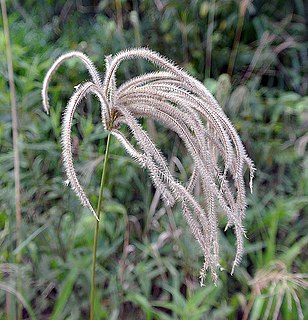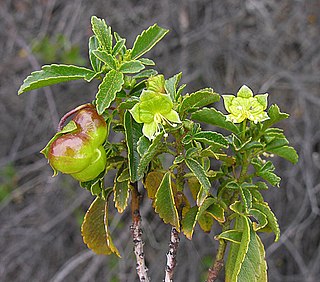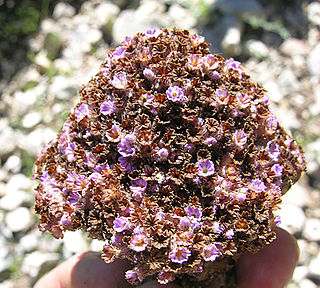
Christian Horace Benedict Alfred Moquin-Tandon was a French naturalist and doctor.
Wittmackia is a genus in the family Bromeliaceae.
Julian Alfred Steyermark was an American botanist. His focus was on New World vegetation, and he specialized in the family Rubiaceae.

Erechtites is a genus of flowering plants in the daisy family known commonly as fireweeds or burnweeds. They are native to the Americas and Australia, but some species are widely distributed weeds.
Laennecia or Laënnecia is a genus of flowering plants in the family Asteraceae. The plants are native to Mesoamerica, South America, and the southwestern United States. Common name is "horseweed."
Radlkoferotoma is a genus of South American flowering plants in the family Asteraceae.
Steyermarkochloa is a genus of plants in the grass family. The only known species is Steyermarkochloa angustifolia(Spreng.) Judz., which is native to Colombia (Guainía), Venezuela (Amazonas), and Brazil (Amazonas).
Tournaya is a monotypic genus of flowering plants belonging to the family Fabaceae. It just contains one species, Tournaya gossweileri(Baker f.) A.Schmitz
Miersiella is a monotypic genus of flowering plants in the Burmanniaceae, first described as a genus in 1903. It contains only one known species, Miersiella umbellataUrb. It is native to South America.

Stapfochloa is a genus of grasses. It is also in the subfamily Chloridoideae, and the Cynodonteae tribe.

Llagunoa is a genus of flowering plants belonging to the family Sapindaceae.

Lennoa is a monotypic genus of flowering plants belonging to the family Boraginaceae. It only contains one known species, Lennoa madreporoidesLex. It is within the subfamily of Lennoaceae.
Salzmannia is a genus of flowering plants belonging to the family Rubiaceae.
Ruyschia is a genus of flowering plants belonging to the family Marcgraviaceae.
Ruizterania is a genus of flowering plants belonging to the family Vochysiaceae.
Huberopappus is a monotypic genus of flowering plants belonging to the family Asteraceae. It only contains one species, Huberopappus maigualidae.
Neonelsonia is a monotypic genus of flowering plants belonging to the family Apiaceae. It just contains one species, Neonelsonia acuminata(Benth.) J.M.Coult. & Rose It is part of Trbie Selineae.
Koyamaea is a monotypic genus of flowering plants belonging to the family Cyperaceae. The only species is Koyamaea neblinensisW.W.Thomas & G.Davidse.
Purdieanthus is a monotypic genus of flowering plants belonging to the family Gentianaceae. The only known species is Purdieanthus pulcher.
Passovia is a genus of flowering plants belonging to the family Loranthaceae.





